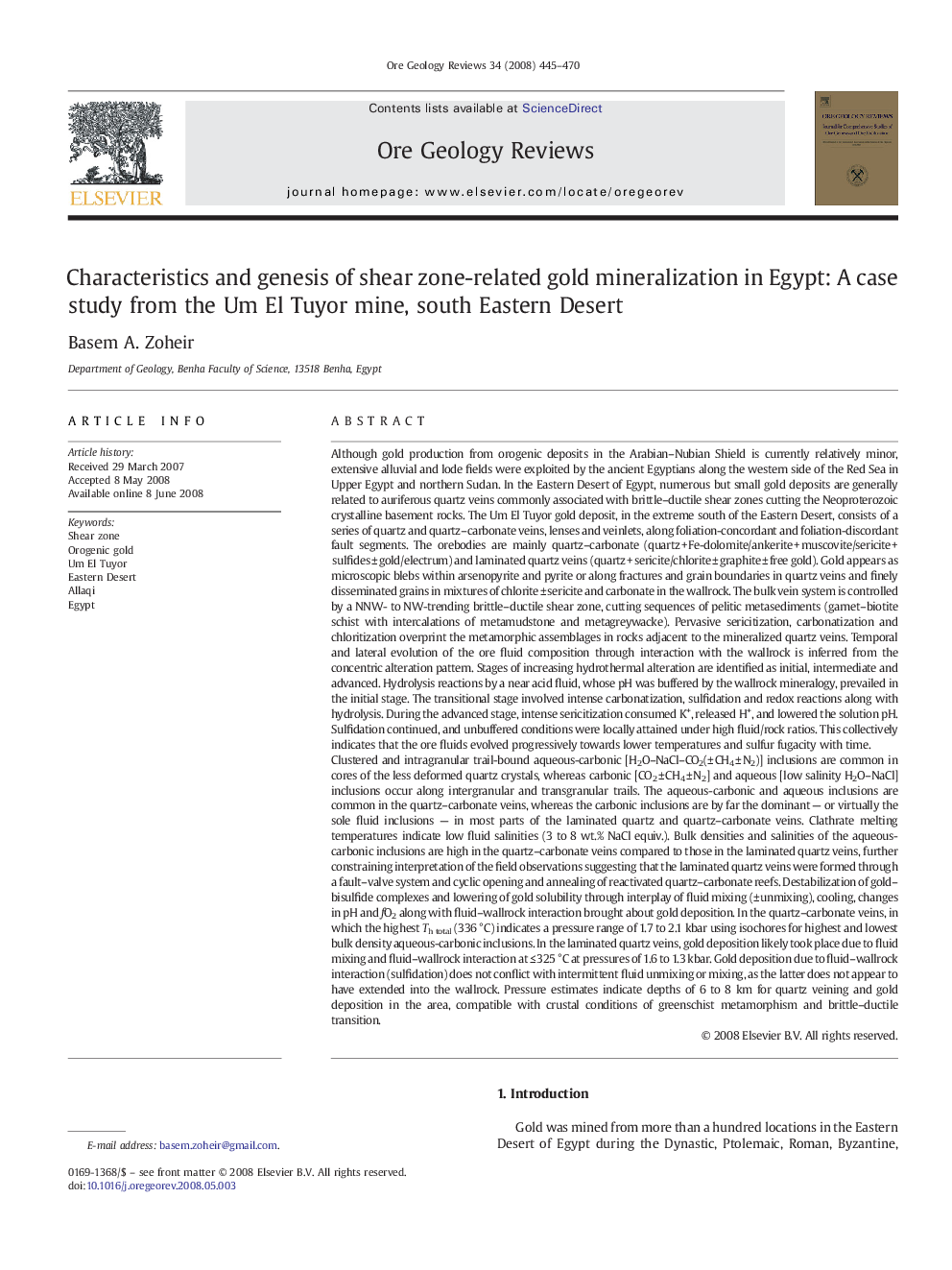| کد مقاله | کد نشریه | سال انتشار | مقاله انگلیسی | نسخه تمام متن |
|---|---|---|---|---|
| 4697982 | 1351915 | 2008 | 26 صفحه PDF | دانلود رایگان |

Although gold production from orogenic deposits in the Arabian–Nubian Shield is currently relatively minor, extensive alluvial and lode fields were exploited by the ancient Egyptians along the western side of the Red Sea in Upper Egypt and northern Sudan. In the Eastern Desert of Egypt, numerous but small gold deposits are generally related to auriferous quartz veins commonly associated with brittle–ductile shear zones cutting the Neoproterozoic crystalline basement rocks. The Um El Tuyor gold deposit, in the extreme south of the Eastern Desert, consists of a series of quartz and quartz–carbonate veins, lenses and veinlets, along foliation-concordant and foliation-discordant fault segments. The orebodies are mainly quartz–carbonate (quartz + Fe-dolomite/ankerite + muscovite/sericite + sulfides ± gold/electrum) and laminated quartz veins (quartz + sericite/chlorite ± graphite ± free gold). Gold appears as microscopic blebs within arsenopyrite and pyrite or along fractures and grain boundaries in quartz veins and finely disseminated grains in mixtures of chlorite ± sericite and carbonate in the wallrock. The bulk vein system is controlled by a NNW- to NW-trending brittle–ductile shear zone, cutting sequences of pelitic metasediments (garnet–biotite schist with intercalations of metamudstone and metagreywacke). Pervasive sericitization, carbonatization and chloritization overprint the metamorphic assemblages in rocks adjacent to the mineralized quartz veins. Temporal and lateral evolution of the ore fluid composition through interaction with the wallrock is inferred from the concentric alteration pattern. Stages of increasing hydrothermal alteration are identified as initial, intermediate and advanced. Hydrolysis reactions by a near acid fluid, whose pH was buffered by the wallrock mineralogy, prevailed in the initial stage. The transitional stage involved intense carbonatization, sulfidation and redox reactions along with hydrolysis. During the advanced stage, intense sericitization consumed K+, released H+, and lowered the solution pH. Sulfidation continued, and unbuffered conditions were locally attained under high fluid/rock ratios. This collectively indicates that the ore fluids evolved progressively towards lower temperatures and sulfur fugacity with time.Clustered and intragranular trail-bound aqueous-carbonic [H2O–NaCl–CO2(± CH4 ± N2)] inclusions are common in cores of the less deformed quartz crystals, whereas carbonic [CO2 ± CH4 ± N2] and aqueous [low salinity H2O–NaCl] inclusions occur along intergranular and transgranular trails. The aqueous-carbonic and aqueous inclusions are common in the quartz–carbonate veins, whereas the carbonic inclusions are by far the dominant — or virtually the sole fluid inclusions — in most parts of the laminated quartz and quartz–carbonate veins. Clathrate melting temperatures indicate low fluid salinities (3 to 8 wt.% NaCl equiv.). Bulk densities and salinities of the aqueous-carbonic inclusions are high in the quartz–carbonate veins compared to those in the laminated quartz veins, further constraining interpretation of the field observations suggesting that the laminated quartz veins were formed through a fault–valve system and cyclic opening and annealing of reactivated quartz–carbonate reefs. Destabilization of gold–bisulfide complexes and lowering of gold solubility through interplay of fluid mixing (± unmixing), cooling, changes in pH and fO2 along with fluid–wallrock interaction brought about gold deposition. In the quartz–carbonate veins, in which the highest Th total (336 °C) indicates a pressure range of 1.7 to 2.1 kbar using isochores for highest and lowest bulk density aqueous-carbonic inclusions. In the laminated quartz veins, gold deposition likely took place due to fluid mixing and fluid–wallrock interaction at ≤ 325 °C at pressures of 1.6 to 1.3 kbar. Gold deposition due to fluid–wallrock interaction (sulfidation) does not conflict with intermittent fluid unmixing or mixing, as the latter does not appear to have extended into the wallrock. Pressure estimates indicate depths of 6 to 8 km for quartz veining and gold deposition in the area, compatible with crustal conditions of greenschist metamorphism and brittle–ductile transition.
Journal: Ore Geology Reviews - Volume 34, Issue 3, November 2008, Pages 445–470